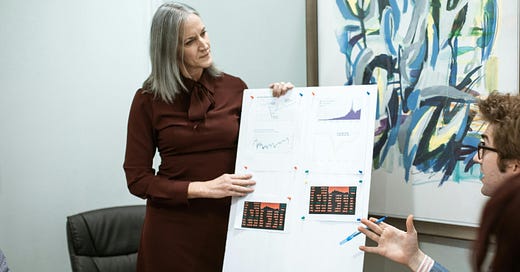Hey! Before we get started here, I want to thank a loyal reader (you know who you are!) who suggested this topic. Thank you! I take those suggestions seriously. If you have a topic you’d like to see covered, drop me a note or use this form.
I was nervous but prepared as I launched “share screen” on Zoom. The small team of executives in the presentation were attentive, but you know how Zoom is … I wasn’t sure I really had their attention.
Things started well—they laughed at a joke, smiled politely.
The first question came about three slides in. Then another question. By the fourth slide, I knew I’d never reach the fifth.
My pitch to these leaders had officially gone off the rails.
The experience taught me a valuable lesson, and today I want to share that tip with you. Here it is in one sentence:
When you need to make your case to an executive, put your conclusion first.
Let’s say you’ve been researching software recommendations for months. It’s time to share your recommendation with the CEO. This has been a lot of work for you. Of course you want the CEO to know how thorough you’ve been.
In this case, you might be tempted to structure your presentation this way, which is roughly chronological:
Our requirements
The research we did
The options we considered
How we narrowed the list
How we tested and evaluated these options
Our recommendation
Let’s say each of those bullet points takes 3 minutes to explain.
6 points
x 3 minutes
= an 18 minute presentation
You’re expecting a top executive to sit silently for 18 minutes? Not going to happen.
Executives often prefer efficiency—getting the critical insight first, then delving deeper if needed
Instead, try this structure:
Our recommendation
Brief explanation of why
“I’m happy to walk you through our process if you want, but what questions do you have?”
Start with your conclusion, say just enough to convince them you did your work, and then ask where they want more information.
You can probably do this in 3 minutes or less. (And hopefully your executives have that kind of attention span.) Let them guide where the conversation goes deeper.
When to use this approach, and when to skip it
Is it always appropriate to start with the conclusion?
The answer to every question that includes the word “always” is always “No!”
Of course there are times where more information is expected in the presentation. If you’re pitching to a potential client, for example, the executive will want more detail. And if the leadership team has asked for a thorough reporting of the next marketing campaign, they’ll expect more than my “start at the end” approach can offer.
Use your best judgment. But no matter what, build in a question early, so you can shape the direction of your presentation based on the needs of the executive team.
I also don’t advise using this start-with-the-end approach when talking with direct reports. Instead, when talking to direct reports, help your team members see how and why you made a decision.
This kind of connecting-the-dots discussion helps your team see your mind at work; they can learn how your thinking evolves, and begin to anticipate what’s coming next. Or even advance their own thinking. That takes more time, and more details.
But this is NOT the way to talk to senior leaders.
When talking with executives, it’s almost always best to share your insights and then invite their perspectives. This is your chance to impress them, but also to learn from them.
Remember, clarity and brevity are your best allies when talking to executives. Start strong, share your insight, and let the conversation unfold from there
BONUS QUESTION
What do people come to you for help with? I heard this question on the Off the Grid podcast. When podcast guest Dacy Gillespie was asked this question, she realized her friends came to her for fashion help. She now runs Mindful Closet, a body positive fashion styling company. What’s YOUR answer to that question? Who knows, maybe it’s your next business idea!
CAN YOU HELP ME OUT?
An upcoming newsletter will ask, how do we make a good transition between home and work, or vice versa? Do you have a ritual that helps you leave one and start the other? A tip or trick you’ve found helpful? Let me know!
Are we connected on social media?
Photo by RDNE Stock project.









